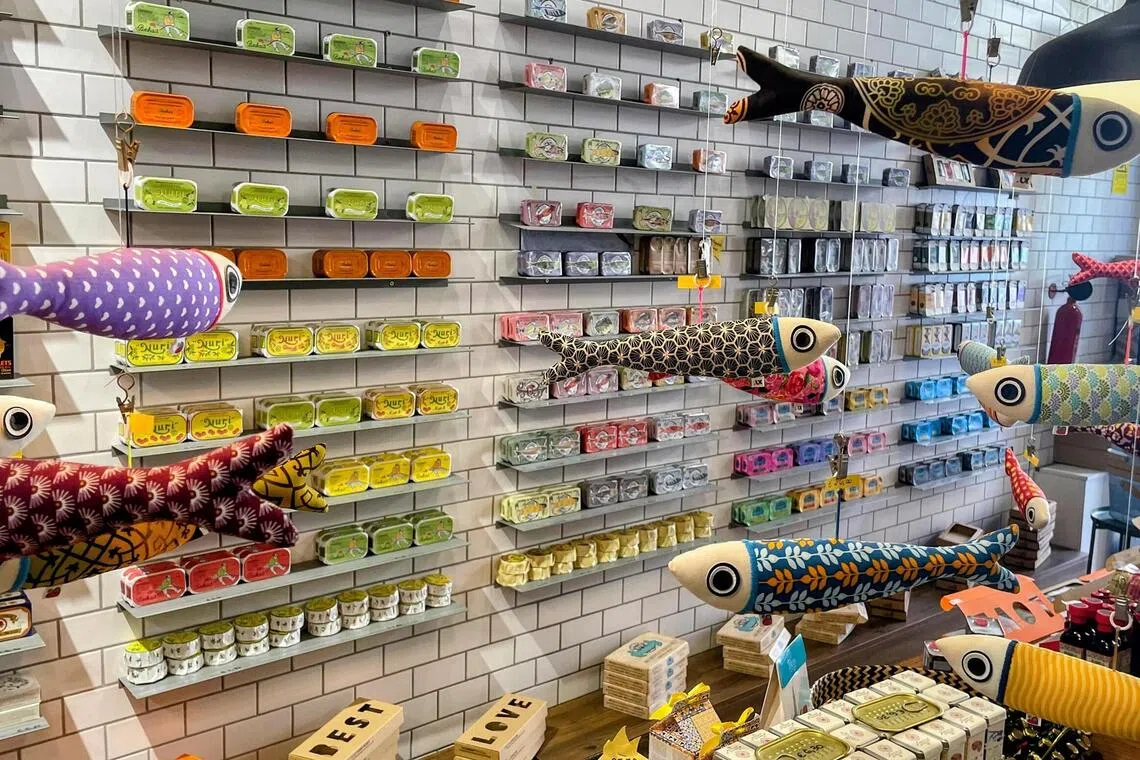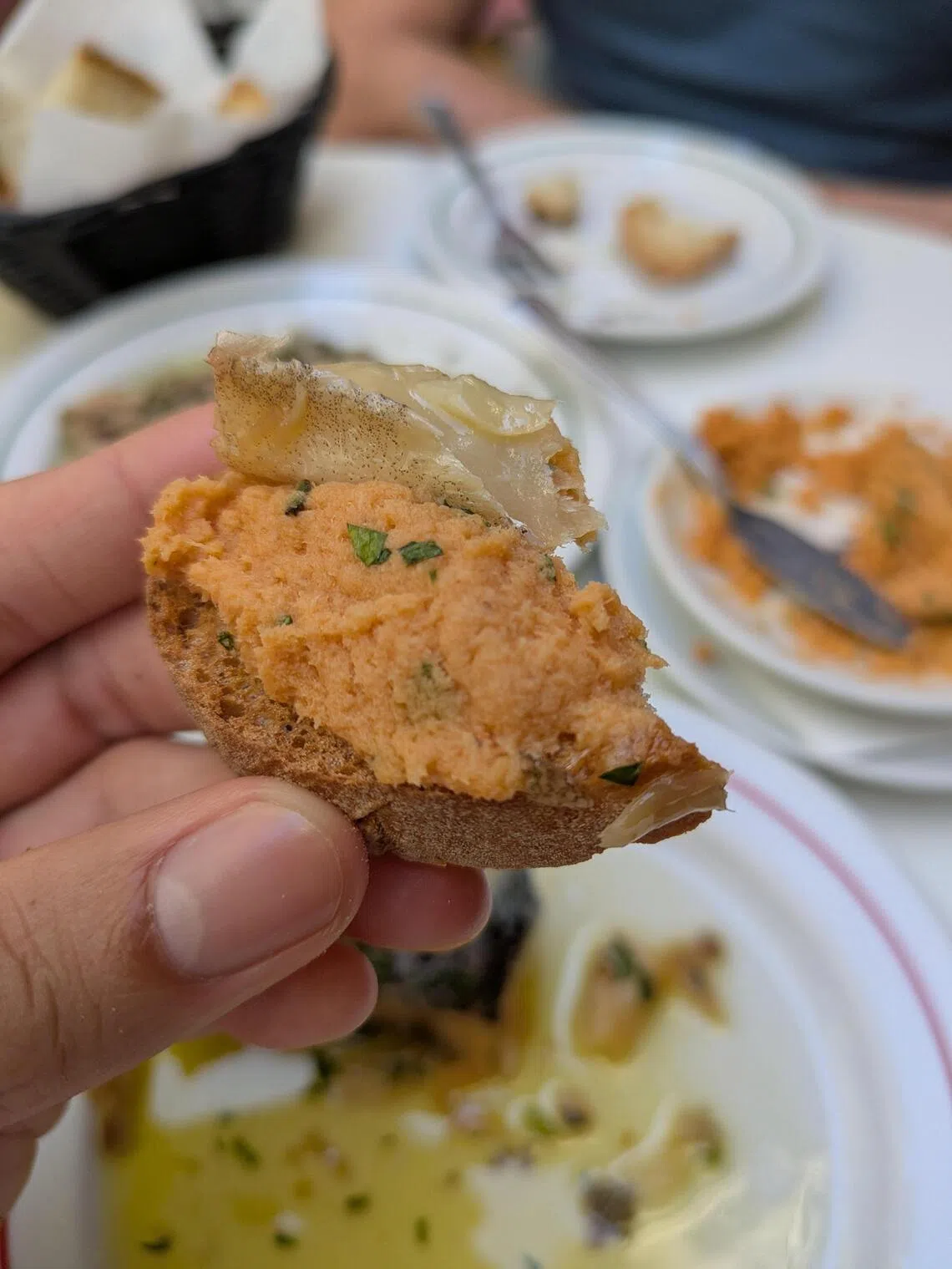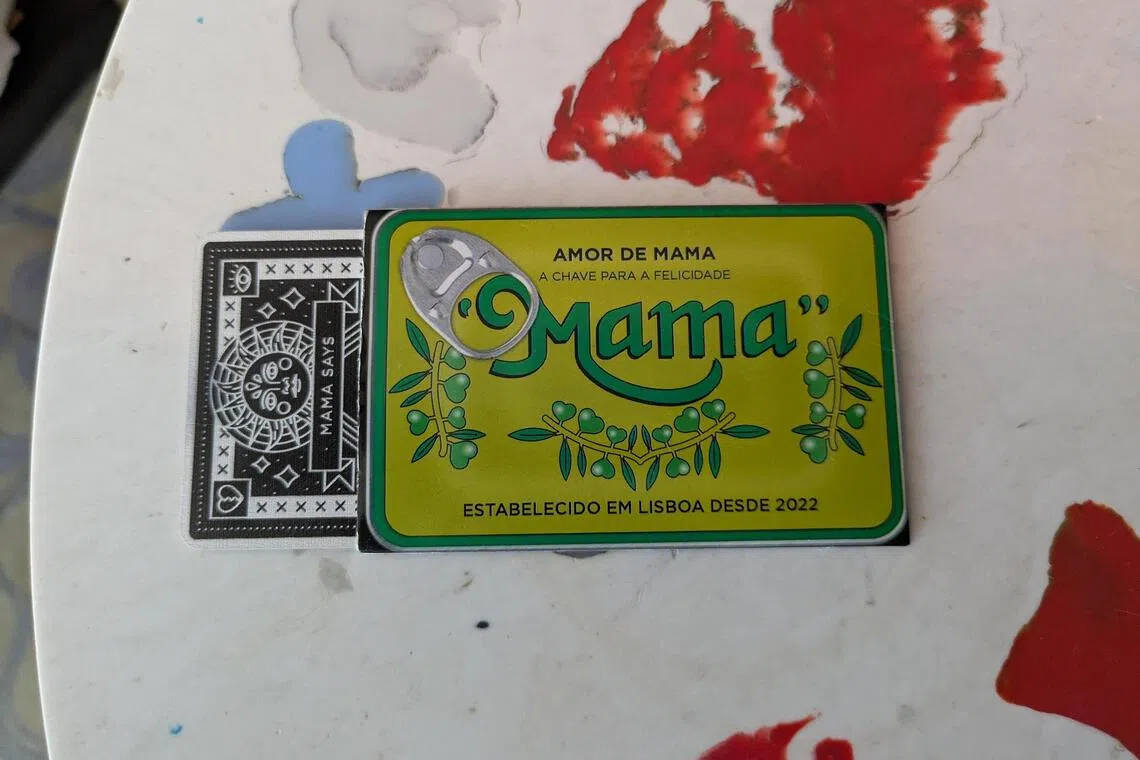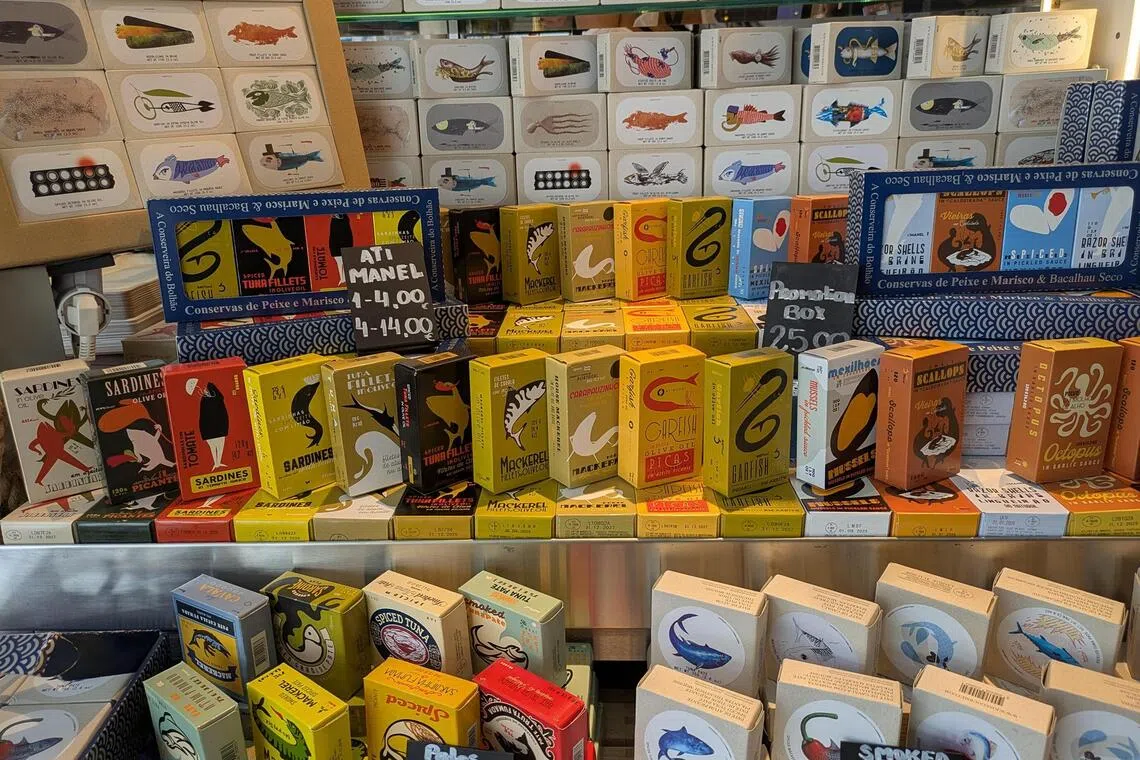Portugal’s hottest dish is a $10 tin of fish
Sign up now: Get ST's newsletters delivered to your inbox

A selection of Portuguese canned seafood. TikTok videos tagged with #sardines, #tinnedfish and #tinnedfishtok had accumulated more than 290 million, 94 million and 41 million views respectively.
ST PHOTO: TEO KAI XIANG
Follow topic:
- Portuguese tinned fish is booming due to #tinnedfishtok with beautifully designed cans and affordable luxury.
- Shops are attracting tourists with colourful displays and premium products like gold-flaked sardines.
- Despite being traditionally a "poor man's food", artisanal tinned fish offers diverse flavours and is gaining popularity in Singapore.
AI generated
LISBON – Is your trip to Portugal complete without tasting a can of fish? Increasingly, businesses in the country are betting that it is not.
Over the past decade, The Fantastic World of the Portuguese Sardine, a local fish cannery that operates stores selling its tinned goods, has grown from a single store in Portugal to 22 branches. The company opened its first international location in New York City’s Times Square in 2023.
In Lisbon and Porto, the country’s major tourism hubs, a growing number of small independent stores have also emerged to meet the increasing tourist demand for canned fish.
Fuelling this niche boom is the rise of tinnedfishtok. According to the last available data, as at 2023, TikTok videos tagged with #sardines, #tinnedfish and #tinnedfishtok had accumulated more than 290 million, 94 million and 41 million views respectively.
On the platform, Chinese-American content creators like Ms Mei Liao have popularised a subgenre of content that involves opening up a colourfully decorated tin of fish, before incorporating it as part of a dish like salad or pasta.
These videos appeal with beautifully designed cans, affordable luxury – with tins of more uncommon seafood such as tuna belly, mussels and octopus starting at around $15.
After all, tinned food is often seen by many as the budget alternative to fresh produce, so the idea that it could also be delicious taps TikTok’s engagement-maximising algorithm.
As someone whose TikTok feed has long decided that I need to see more tinned fish, my 15-day trip to Portugal in July is not complete without a taste of the local canned food and a conversation with locals about tourists’ newfound fishy appetites.
Wall-to-wall fish in Porto

The Fantastic World of the Portuguese Sardine is a national chain that emerged out of the Comur cannery, which was established in 1942.
ST PHOTO: TEO KAI XIANG
Stepping into one of the Porto branches of The Fantastic World of the Portuguese Sardine, I encounter a cacophony of sounds and colours that would not be out of place in a circus.
Cans of tinned fish are presented in machines resembling Ferris wheels, while the most premium grade of sardines is stored in gold bar-like cans, with a giant novelty vault to match.
Seizing on tinned fish’s souvenir potential, the store presents a selection of sardines in decorative cans stating a year – which has no bearing on when the fish inside was caught or canned – plus some fun facts about that year.
For instance, I learn that 1996 was when American actress Zendaya and Dolly the sheep, the first cloned animal, were born.
It feels like the tourist trap equivalent of tinned fish tourism, complete with sometimes eyebrow-raising prices. The cheapest can of sardines costs €6.50 (S$9.80), while the most expensive – sardines in extra virgin olive oil with gold flakes packaged in gold bar tins – is €22.
“The trend might be recent, but the fascination is ancient,” says Ms Sonia Santiago, marketing director of the chain’s parent company, Grupo O Valor do Tempo.
Portuguese canned fish has more than a century of history in Portugal, but long before that, Phoenicians were already salting sardines along the Atlantic coast.
“What the world now sees as a trend has always been a tradition here. This current revival is, in fact, a renewed appreciation of ancestral know-how, preserved by artisans who still work by hand today,” Ms Santiago says.

The Douro River in Porto is lined with bars and restaurants serving glasses of port with local seafood dishes such as Bacalhau a Bras.
ST PHOTO: TEO KAI XIANG
Trekking across the picturesque Douro River after a few glasses of port – fortified wine originating from the region – I meet Portuguese worker Marta Martins, who offers a humbler explanation.
“All my life, I’ve had canned fish. Tuna and sardines,” she tells me, explaining that it has long been an affordable staple of working- and middle-class families.
“If you mix it with very good olive oil, it’s the best,” she recommends.

Customers at Loja das Conservas can have a quick meal there by buying a can of fish and pairing it with wine, cheese and bread.
PHOTO: ELLIOT NAPIER
Her store, Loja das Conservas, takes a different approach when it comes to wooing tourists. Those who buy cans can open them up in the store and pair them with an assortment of wine, cheese and bread for a quick, no-frills meal.
After a week of holidaying in Spain, my travel companion and I share a can of sardines and mackerel pate alongside our home-cooked dinner of lemon and garlic pasta, pairing it with a glass of ruby port.
Mixed into our pasta, along with the lemon sauce in the can, the sardines add a zesty kick to a simple meal, while the buttery pate spreads deliciously on bread.

A meal of pasta, mackerel pate and sardines.
ST PHOTO: TEO KAI XIANG
What makes Portuguese varieties different is not only the diversity – everything from squid in ink to clams – but also how the canning process creates a taste distinct from the canned food sold at Singapore supermarkets.
The best Portuguese tinned fish comes hand-packed rather than machine-filled, something that can be seen in the delicate construction of each tin’s contents. Instead of hunks of meat, they come in slices, with seasoning distributed evenly. The taste is also milder, with less reliance on overpowering sauces.
Singaporean tinned fish connoisseur Jay Chua – co-founder of Fossa Provisions, which distributes the fish in Singapore – attributes it to how Portuguese canning typically uses fresh rather than frozen fish. This contributes to a less fishy taste and a texture that is less mushy.
Lisbon, capital of cans

Tinned codfish and trout pate on bread at Sol e Pesca in Lisbon.
ST PHOTO: TEO KAI XIANG
While travelling from Porto to Lisbon, I find that “petiscarias” (snack bars) are plentiful in the wake of the country’s foodie tourism boom.
Our first stop, Sol e Pesca ( instagram.com/solepesca
Here, we dine on tins of mackerel, codfish and trout pate while drag queens roller-skate on the neon-pink road. The delicate and flaky cod has me longing for a fuller main of Portugal’s national fish. The meal, including two pints of beer, costs €29.

An afternoon snack at Miss Can in Lisbon is an ideal reprieve from the city’s steep slopes.
PHOTO: ELLIOT NAPIER
After a gruelling climb in the summer heat up the Portuguese capital’s steep slopes to the historic castle Castelo de Sao Jorge, we stumble upon Miss Can ( miss-can.com/en
Our meal of stuffed squid with vegetables, as well as rice and mackerel in spicy olive oil – both from tins – with housemade lemonade and bread, sets us back €20.99. Each forkful of tender squid bursts with flavour.
Near the end of our time in Portugal, we visit specialist grocery store Conserveira de Lisboa to stock up on souvenirs, spending close to $100 on a dozen tins. The family-run store seems like the best place for a good deal, with cans bundled in twine that customers can loop around their fingers, dangling their purchases on the walk home.

Canned fish has seeped into the design of Portugal’s tourism attractions, such as this hotel keycard from Mama Shelter Lisboa.
ST PHOTO: TEO KAI XIANG
Having sampled a total of around 10 tins, my takeaway is that while sardines are the classic starting point, they can be polarising. While canning’s gelification process may render sardine bones edible, their crunchy texture is not for everyone.
Most other varieties – mackerel, tuna and codfish – have their bones removed before canning, providing a more accessible entry point. These pair well with bread or pasta as a snack. Fish in lemon sauce or spicy oil can add a zing of flavour when mixed into an aglio olio pasta.
My favourites, however, are the varieties at the highest and lowest end of the price scale. Mussels, squid and octopus, as well as pate – typically the cheapest – offer more complex flavours and a sweetness that other seafood lacks.
Tinned fish in Singapore

Portugal’s colourful tinned fish varieties extend beyond the usual sardines and tuna.
ST PHOTO: TEO KAI XIANG
Those in Singapore looking for a taste of tinned fish need not travel all the way to Portugal.
Fossa Provisions’ Mr Chua says the past year has seen an uptick in can varieties imported into the Republic. This is likely due to Singaporeans returning from holidays in Spain or Portugal, as well as customers expressing curiosity about the colourful cans they see on social media.
Fossa Provisions imports a variety of Portuguese, Spanish and Japanese tinned fish into Singapore, selling them online ( fossaprovisions.com
His advice for those new to tinned fish: Look beyond the packaging. Old-school varieties can offer delicious contents even with “half-effort marketing”. With more modern-looking cans, he suggests looking out for canneries doing something special with a unique sauce or a regional speciality.
For instance, Japanese cannery Takenaka Canning’s smoked firefly squid ($16) and trumpet snail ($18) cans are specialities of the idyllic Kyoto fishing village of Miyazu.
“Some people are put off by the slightly higher price tag of artisanal tinned seafood because they are used to the cheap mass-produced tins found here,” he says.
“I advise them to visit their local wet market and try buying fresh fish. They will learn that the freshest, wild-caught tasty fishes are never cheap. If a tin is very cheap, it is likely the seafood used is not the best.”


